There is a lot to like about Buffer. It is a fantastic social media publishing tool, with a lucid dashboard and simple set-up process. But does it have enough advanced features to appeal to complex social media teams?

Pro: $15/month, 1 user, 8 social profiles, 100 scheduled posts
Premium: $65/month, 2 users, 8 social profiles, 2,000 scheduled posts
Business: $99/month, 6 users, 25 social profiles, 2,000 scheduled posts
-
Ease Of useRating image, 5.00 out of 5 stars.5.00/5 Our ratings are based on a 5 star scale. 5 stars equals Best. 4 stars equals Excellent. 3 stars equals Good. 2 stars equals Fair. 1 star equals Poor. We want your money to work harder for you. Which is why our ratings are biased toward offers that deliver versatility while cutting out-of-pocket costs.
= Best
= Excellent
= Good
= Fair
= Poor
SupportRating image, 3.50 out of 5 stars.3.50/5 Our ratings are based on a 5 star scale. 5 stars equals Best. 4 stars equals Excellent. 3 stars equals Good. 2 stars equals Fair. 1 star equals Poor. We want your money to work harder for you. Which is why our ratings are biased toward offers that deliver versatility while cutting out-of-pocket costs.
= Best
= Excellent
= Good
= Fair
= Poor
PricingRating image, 3.00 out of 5 stars.3.00/5 Our ratings are based on a 5 star scale. 5 stars equals Best. 4 stars equals Excellent. 3 stars equals Good. 2 stars equals Fair. 1 star equals Poor. We want your money to work harder for you. Which is why our ratings are biased toward offers that deliver versatility while cutting out-of-pocket costs.
= Best
= Excellent
= Good
= Fair
= Poor
FeaturesRating image, 2.50 out of 5 stars.2.50/5 Our ratings are based on a 5 star scale. 5 stars equals Best. 4 stars equals Excellent. 3 stars equals Good. 2 stars equals Fair. 1 star equals Poor. We want your money to work harder for you. Which is why our ratings are biased toward offers that deliver versatility while cutting out-of-pocket costs.
= Best
= Excellent
= Good
= Fair
= Poor
-
- Very easy to use
- Great for publishing and scheduling posts
- Free account available
- Limited social listening capabilities
- No support via phone or live chat
- The price can add up if you need multiple subscriptions
The height of achievement for a modern technology is to be so closely aligned with an action that the product name becomes a verb.
We can Tweet, we can Skype, and we can Buffer.
To Buffer social media content means to publish it to multiple channels, using the Buffer Chrome extension or the Buffer software.
Since its launch in 2010, this has been Buffer's flagship feature and today, it still stands out as a streamlined social media tool. It contains excellent tools for publishing posts across all major social networks and has a user-friendly interface.
Anyone can become a Buffer power user with just a bit of practice, which sets it apart from the feature-heavy rivals that can overwhelm users with their surfeit of choices.
However, Buffer wants to be much more than this. It now consists of three products, each requiring its own subscription.
The classic Buffer tools are contained within the Publish product; Reply helps to manage social media conversations; and Analyze is designed for reporting.
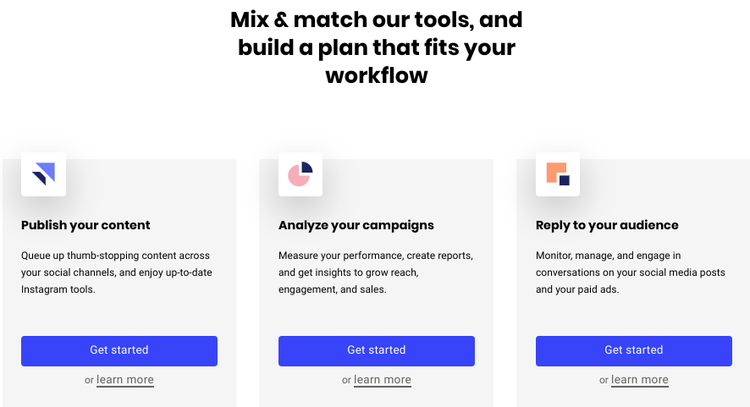
Buffer contains three separate products. Users can mix and match to create their own social media management package. Image source: Author
So, are Buffer's new capabilities enough to merit a redefinition of what 'to Buffer' means?
Who is Buffer for?
Buffer will have the maximum positive impact for small social media teams and small businesses. Anyone that is looking for an accessible, effective platform to create and post more successful social media content will find a lot to like here. Everything you need to get started is contained within one screen.
Moreover, Buffer has continued to build on its core strengths and has added tools such as Pablo to make it even easier to create unique content within the platform.
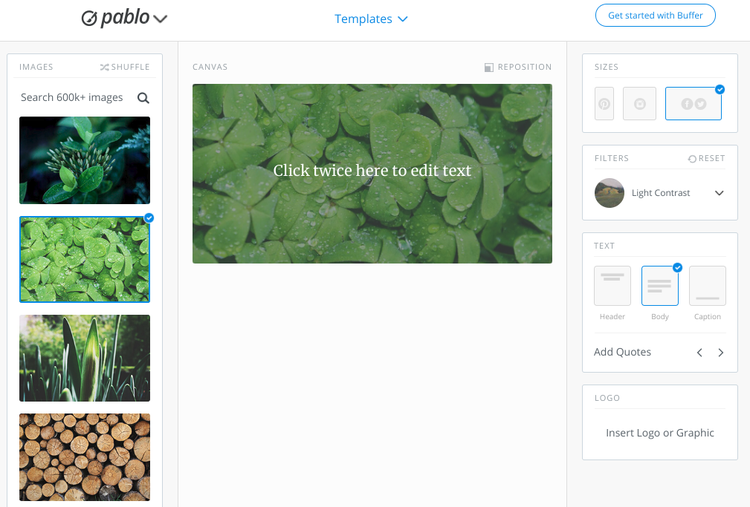
Pablo is a valuable tool for creating unique social media content. Image source: Author
The free account connects with three social accounts and permits ten scheduled posts, so it is a genuine option for independent business owners.
The lower-end packages are reasonably priced too, if you need to upgrade from the free account for more flexibility.
Larger teams will need to shell out for the Business packages on Buffer, as the entry-level packages cover only one user.
At this end of the pricing spectrum, there are more comprehensive solutions available. For example, Buffer lacks cloud integration with the likes of Google Drive to import content for social media posts. It also lacks the conversion tracking and paid social features found on Hootsuite or Sprout Social.
As such, larger businesses may wish to use Buffer for its fantastic publishing tools, but may feel the need to complement this subscription with other tools for content management and social listening.
For some, Buffer will be a refreshingly streamlined experience.For others, it will seem a little lightweight when stacked alongside the feature-packed competition.
Buffer's features
As mentioned above, Buffer is split into three products: Publish, Reply, and Analyze.
This is suitably aligned with three of the main actions a social media professional needs to undertake every day.
Therefore, our feature review will follow that structure, highlighting the key features found within each of the three products.
Buffer Publish
Buffer Publish is fantastic for planning and posting content. The layout is clean and navigable, with plenty of options for link shortening.
The process for posting new content is straightforward, but still contains some convenient extra features.
For example, when you enter a link you would like to share, Buffer will show you a preview of how it will look when posted on each of your chosen social networks. For Instagram, you can include a first comment along with your post, should you wish to add more hashtags to extend the content's reach.
Many businesses will find it useful to manage this so swiftly, within one screen.
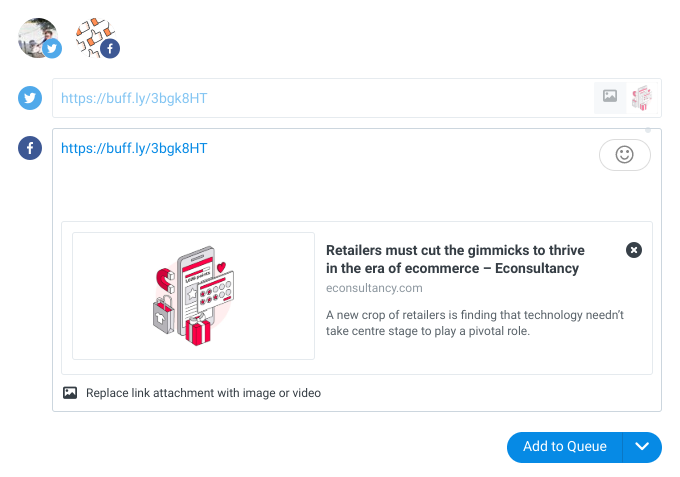
Buffer's publishing tools are great and they contain a number of handy features. Image source: Author
It is also simple to set up a schedule for specific posting times across multiple dates, as in the screenshot below:

The Buffer posting schedule is well designed, reliable, and highly effective. Image source: Author
This makes it easy to drag and drop specific pieces of content into your content calendar schedule, but also to view your strategy from a broader perspective.
Buffer posting options are available for Twitter, Facebook, Instagram, LinkedIn, and Pinterest, thus covering the major social networks for most businesses.
It is also worth noting that Buffer can integrate with a wide variety of other apps and extensions, including IFTTT, Feedly, and WordPress.
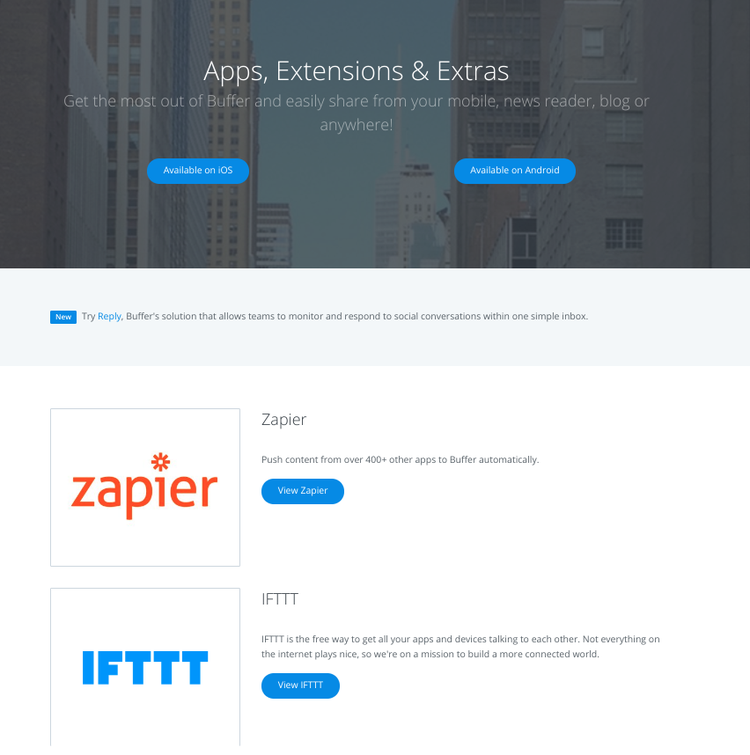
Buffer offers a superb selection of third-party integrations through its App, Extensions, and Extras section. Image source: Author
From personal experience, Buffer Publish is highly reliable when it comes to scheduled posts. Companies need to trust that their social media management tool will carry out these tasks so they can focus their attention on other tasks. Buffer has you covered, in that respect.
It is possible to collaborate with other members of your team on posts within Buffer Publish too, but you will need to go for the Premium (two users) or Business (six users) plan to access these tools. The free plan and the Pro plan are both restricted to one user, so their opportunities for collaboration are limited.
Buffer Reply
Buffer Reply is one of the new products Buffer has added, with a focus on helping businesses manage their social media conversations.
One of the key features here is the social inbox, which collates inbound messages from all your social networks into one feed. No doubt, this will be a real time-saver for many businesses.
Buffer Reply also contains reports for your company's response times to messages, which can be segmented to highlight performance for each social media team member.
As with Publish, you will need to upgrade to a Business account plan to make use of these features.
Should you opt to do so, you will also have access to some very beneficial automation tools. For example, it is possible to set up a rule to identify keywords in comments and assign them to specific team members. This is not the most glamorous automation tool on the market today, but it is certainly useful.

Buffer makes automation easy and practical with its user-friendly rules. Image source: Author
Social listening also falls under the 'Buffer Reply' category, although it is still in the early stages of development. For now, it works well to monitor trends on Twitter, but lacks the impressive capabilities of Hootsuite or Sprout Social on other social networks.
Buffer Analyze
Buffer analytics has undergone a dramatic transformation, re-emerging as Analyze. While there are some rudimentary marketing analytics options contained within Buffer Publish, all of the platform's advanced analytics options are now within the Analyze product.
Within Analyze, the main Buffer dashboard displays an aggregate of recent performance updates, along with specific metrics for your latest posts.
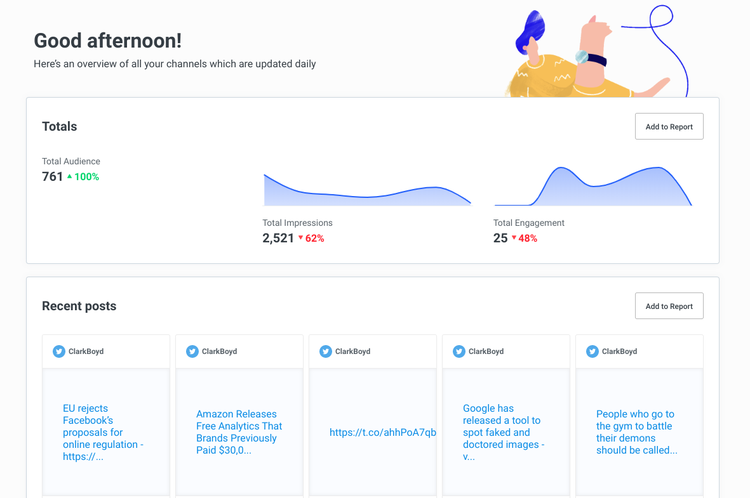
The home Buffer dashboard contains the headline figures, so you'll know pretty quickly if your social strategy is going to plan or not. Image source: Author
It is very easy to set up new templates and you can click 'Add to report' on any graph within Buffer to add it to one of your dashboards.
That simplicity will appeal to businesses that need to report on key metrics like reach, engagement rate, and followers.
The Answers tab is also very insightful, providing tips on when to post content, what types of media assets you should use, and how often to post on each channel.
That said, for those that need additional detail about their social media advertising performance, Buffer Analyze may lack the required depth.
Moreover, while Analyze is an effective reporting tool for Twitter, Facebook, and Instagram, it lacks the functionality of its competitors for Pinterest and LinkedIn.
Buffer's ease of use
Buffer eclipses its rivals when it comes to ease of use. There is a pleasing coherence and simplicity to its interface, which is stripped of superfluous features to keep the user's focus on the job at hand.
The set-up process walks the user through the important steps and can connect to social media accounts almost instantly.

You'll be up and running in a matter of seconds with Buffer's social media account connections. Image source: Author
The Buffer app continues this theme, as it is fast, clear, and intuitive. Furthermore, the Buffer Chrome extension is one of the best on the market, allowing users to post directly from web pages to their social media accounts.
Overall, the Buffer user experience is almost effortless. It is an approachable social media management tool for novice users, who can get up and running quickly.
The Buffer Marketing Library is also deserving of a mention here. This knowledge base contains detailed posts around everything you need to know in the world of social media strategy, and it is free to access.
Buffer's pricing
On the face of it, Buffer offers the clearest pricing of any social media management tool.
The 14-day free trial requires no credit card details and the homepage is littered with big, blue buttons asking you to get started.
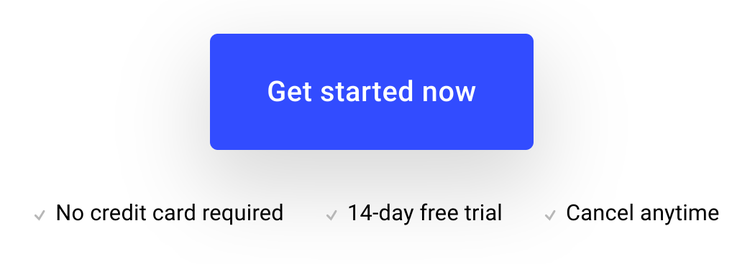
The free trials on Buffer are transparent and straightforward, plus you can cancel at any point. Image source: Author
There is a free account option, which is always welcome, and it allows connection to three social media accounts. For individual users, this means the free account is a viable option for managing multiple social networks from one dashboard. It is also possible to schedule up to ten posts within the free account, and that will be sufficient to cover plenty of smaller businesses.
The mix and match nature of the packages across the Publish, Reply, and Analyze products may appeal to businesses who are tired of shelling out for a lot of features they will never use.
Buffer Publish offers three subscription options, all of which can be paid monthly or annually. As with similar tools, there is a discount for paying upfront for an annual subscription.
The Pro account, at $12/month for one user, connects to eight social media accounts, which should be plenty for solo users and small businesses.
The Premium package, at $56/month for two users, introduces some collaboration tools and allows up to 2,000 scheduled posts.
The Business subscription, at $85/month for six users, can connect with up to 25 social media accounts and is priced competitively.
There is also the option to add users at a rate of $25/month per user, or you can contact Buffer to negotiate a subscription for larger social media teams.
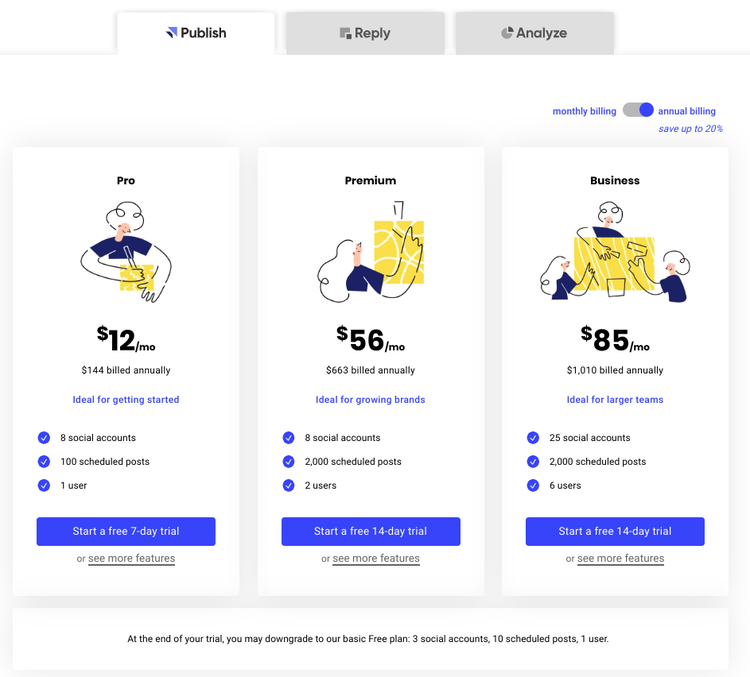
Buffer Publish offers three subscription plans, starting with the approachable Pro option at just $12/month. Image source: Author
As noted previously, to access Buffer's conversation management tools, you will need to add a subscription for Buffer Reply.
Reply offers two options: Pro at $42/month, and Business at $188/month, both of which cover just one user. Again, it is an extra $25/month per user for any additional team members, and those who need the Business account will almost certainly need to take up this option.
It is worth adding that within the Pro account, account data is only available for the past 30 days and reports are limited to just the headline figures. For detailed reports on your social media conversations, you will need to go for the Business account here.
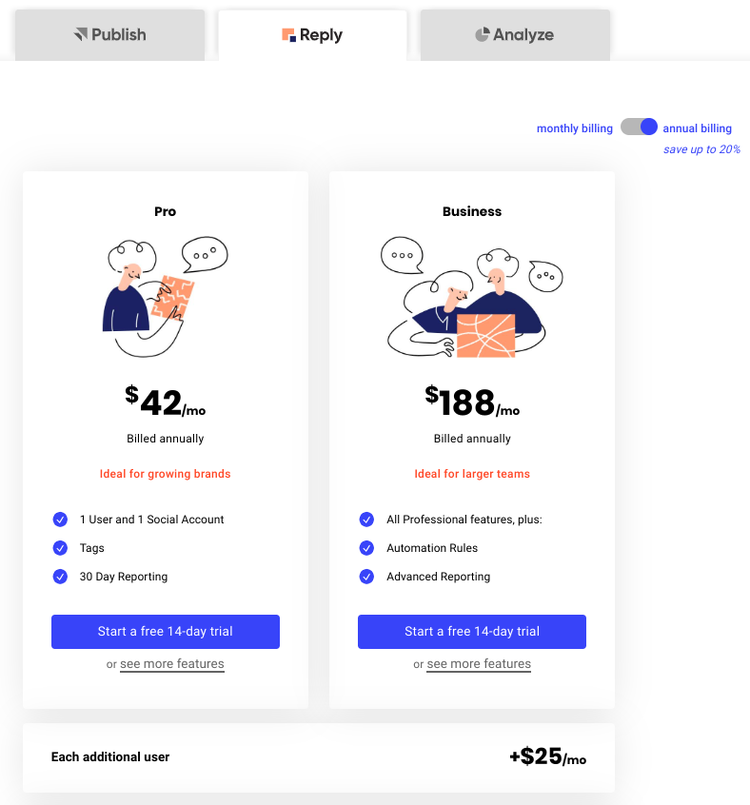
Buffer Reply has two account options, both of which cover one user. It is $25/month for each additional user on top of the core subscription plan. Image source: Author
Next up, Buffer Analyze.
There are two options within Analyze: the Pro account at $28/month, and the Premium account at $40/month.
The main differences between them are that Premium connects to ten social media accounts (compared with eight in the Pro package), Premium integrates with Shopify, and the more expensive account also provides access to Instagram Stories analytics.
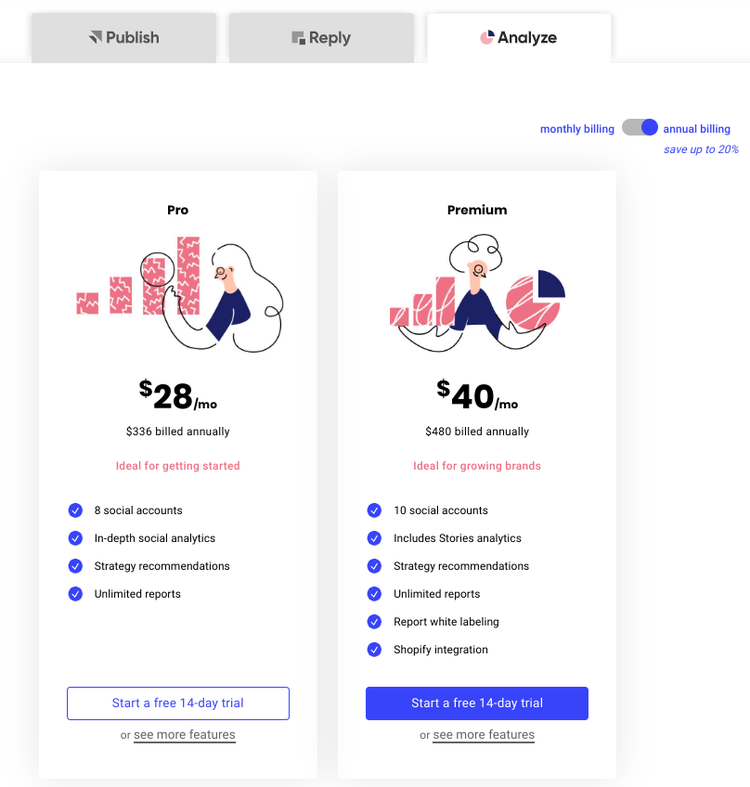
Buffer Analyze offers a Pro and Premium account. You will need to opt for the latter if you want access to Instagram Stories analytics. Image source: Author
So, while this pricing approach is easy to digest at a glance, it also demands closer inspection.
The categories of distinction between the plans differ significantly within each product. In the Publish product, when you upgrade each time, more users are added to your account. For Reply, upgrading does not add any more users, but some customers may be inclined to assume that this would be the case. Instead, they need to pay an additional $25 for each user to access Reply, although they are already included within the Business plan on Publish.
All in all, this mix and match approach will only work in the favor of some businesses. For many, the bill racks up quickly and, should they have to fork out for the most expensive options, there are better options for their marketing technology budget.
Buffer's support
Buffer's support options are surprisingly limited, given its huge list of customers and heritage in the social media management software industry.
There is no phone support available and training options are limited.
Admittedly, the platform is simple to use and there are numerous helpful tips available within each of its features. Moreover, the Buffer knowledge base covers just about every challenge you can think of, with comprehensive resolutions.
Support is available through email as well as Buffer's Facebook and Twitter channels. I have used email and the Buffer Facebook account to make queries; the response time was slightly faster over email, but I received a comprehensive answer with suggested actions through both channels within 24 hours.
Benefits of Buffer
Buffer has always been easy to use, and the new interface reinforces this benefit.
It is a slick, fast, intuitive way to visualize and post better content to your social media channels. The drag-and-drop functionality and the Pablo content creation tools are a joy to use, too.
Buffer was also one of the first social media management tools to allow post scheduling on Instagram, so it is typically among the early movers when new developments arise.
The Buffer app and Chrome extension are fantastic, making it even simpler to post new content and manage your social media presence without disrupting your day too much.
Businesses know what they are getting with Buffer, and it delivers very well on these requirements.
A user-friendly way to manage social media
Many marketing technology companies bemoan the fact that their customers don't use their platform to its full potential. A lot of development time and company resources go into creating fancy new features, so they want to make sure customers see the benefit.
The costs associated with these new features are typically passed onto the customer anyway, of course. Perhaps marketing technology companies should focus their investments on the products they know their customers will want instead.
Buffer takes a refreshingly pragmatic approach to this reality.
It removed some features, such as content recommendations, because they were not central to the company's purpose.
Simplicity often comes at a cost, however.
Buffer's feature list looks a little patchy at the premium end of the scale, when compared to enterprise-level social media management tools.
How Buffer Compares
| Free Account Option | Performance Analytics | Onboarding | Phone Support | |
|---|---|---|---|---|
| Buffer |
|
|
|
|
| Gain |
|
|||
| SocialPilot |
|
|||
| Sprout Social |
|
|
|
|
| Hootsuite |
|
|
|
FAQs
-
Buffer is a reliable, fast way to manage multiple social media accounts, from a user-friendly dashboard.
-
Buffer offers a free account option and there is a free 14-day trial for all of its paid subscription packages.
-
Yes, Buffer can post to Instagram. It can also post to Facebook, Twitter, LinkedIn, and Pinterest.
Our Small Business Expert
We're firm believers in the Golden Rule, which is why editorial opinions are ours alone and have not been previously reviewed, approved, or endorsed by included advertisers. The Ascent does not cover all offers on the market. Editorial content from The Ascent is separate from The Motley Fool editorial content and is created by a different analyst team.